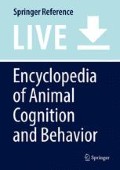References
Arnold, K., & Zuberbühler, K. (2006). Language evolution: Semantic combinations in primate calls. Nature, 441, 303–303. https://doi.org/10.1038/441303a.
Bugnyar, T., Kijne, M., & Kotrschal, K. (2001). Food calling in ravens: Are yells referential signals? Animal Behaviour, 61, 949–958.
Clay, Z., Smith, C. L., & Blumstein, D. T. (2012). Food-associated vocalizations in mammals and birds: what do these calls really mean ?: Animal Behaviour, 83(2), 323–330.
Collier, K., Bickel, B., van Schaik, C. P., Manser, M. B., & Townsend, S. W. (2014). Language evolution: Syntax before phonology? Proceedings of the Royal Society B: Biological Sciences, 281(1788), 20140263.
Crockford, C., Wittig, R. M., Mundry, R., & Zuberbühler, K. (2012). Wild chimpanzees inform ignorant group members of danger. Current Biology, 22, 142–146. https://doi.org/10.1016/j.cub.2011.11.053.
Ducheminsky, N., Henzi, S. P., & Barrett, L. (2014). Responses of vervet monkeys in large troops to terrestrial and aerial predator alarm calls. Behavioral Ecology, 25, 1474–1484. https://doi.org/10.1093/beheco/aru151.
Fitch, W. T. (2010). The evolution of language. Cambridge: Cambridge University Press.
Fitchel, C., & Kappeler, P. M. (2002). Anti-predator behaviour of group living Malagasy primates: Mixed evidence for a referential alarm call system. Behavioral Ecology and Sociobiology, 51, 262–275.
Fuller, J. L. (2014). The vocal repertoire of adult male blue monkeys (Cercopithecus mitis stulmanni): A quantitative analysis of acoustic structure. American Journal of Primatology, 76, 203–216. https://doi.org/10.1002/ajp.22223.
Furrer, R. D., & Manser, M. B. (2009). The evolution of urgency-based and functionally referential alarm calls in ground-dwelling species. American Naturalist, 173, 400–410.
Gill, S. A., & Bierema, A. M.-K. (2013). On the meaning of alarm calls: A review of functional reference in avian alarm calling. Ethology, 119, 449–461. https://doi.org/10.1111/eth.12097.
Griesser, M. (2008). Referential calls signal predator behavior in a group-living bird species. Current Biology, 18, 69–73.
Gros- Lois, J. (2002). Contexts and behavioural correlates of trill vocalizations in wild white-faced capuchin monkeys (Cebus capucinus). American Journal of Primatology: official Journal of the American Socirty of Primatologists, 57(4), 189–202.
Heinrich, B., & Marzluff, J. (1991). Do common ravens yell because they want to attract others? Behavioral Ecology and Sociobiology, 28, 13–21.
Hobaiter, C., & Byrne, R. W. (2014). The meanings of chimpanzee gestures. Current Biology, 24, 1596–1600.
Kern, J. M., Laker, P. R., & Radford, A. N. (2017). Contextual variation in the alarm call responses of dwarf mongooses, Helogale parvula. Animal Behaviour, 127, 43–51.
Macedonia, J., & Evans, C. (1993). Essay on contemporary issues in ethology: Variation among mammalian alarm call systems and the problem of meaning in animal signals. Ethology, 93, 177–197.
Manser, M. B. (2001). The acoustic structure of suricates’ alarm calls varies with predator type and the level of response urgency. Proceedings of the Royal Society of London B: Biological Sciences, 268(1483), 2315–2324.
Manser, M. B. (2016). Referents and semantics in animal vocalizations. In Psychological mechanisms in animal communication (pp. 223–249). Cham: Springer.
Manser, M. B., Seyfarth, R. M., & Cheney, D. L. (2002). Suricate alarm calls signal predator class and urgency. Trends in Cognitive Science, 6, 55–57.
Marler, P., Evans, C. S., & Hauser, M. (1992). Animal signals: Motivational, referential or both? In H. Papoušek, U. Jürgens, & M. Papoušek (Eds.), Nonverbal vocal communication: Comparative & developmental approaches (pp. 66–86). Cambridge, UK: Cambridge University Press.
Ouattara, K., Lemasson, A., & Zuberbühler, K. (2009). Campbell’s monkeys use affixation to alter call meaning. PLoS One, 4, e7808. https://doi.org/10.1371/journal.pone.0007808.
Pika, S., & Bugynar, T. (2011). The use of referential gestures in ravens (Corvus corax) in the wild. Nature Communications, 2, 560.
Scarantino, A., & Clay, Z. (2015). Contextually variable signals can be functionally referential. Animal Behaviour, 100, e1–e8.
Seyfarth, R. M., & Cheney, D. L. (2003). Signalers and receivers in animal communication. Annual Review of Psychology, 54, 145–173.
Seyfarth, R. M., Cheney, D. L., & Marler, P. (1980a). Monkey responses to three different alarm calls: Evidence of predator classification and semantic communication. Science, 210, 801–803.
Seyfarth, R. M., Cheney, D. L., & Marler, P. (1980b). Vervet monkey alarm calls: Semantic communication in a free-ranging primate. Animal Behaviour, 28, 1070–1094.
Slobodchikoff, C. N., & Placer, J. (2006). Acoustic structures in the alarm calls of Gunnison’s prairie dogs. Journal of the Acoustical Society of America, 119, 3153–3160.
Slocombe, K. E., & Zuberbühler, K. (2006). Foodassociated calls in chimpanzees: Responses to food types or food preferences? Animal Behaviour, 72, 989–999. https://doi.org/10.1016/j.anbehav.2006.01.030.
Smith, C. L. (2017). Referential signalling in birds: The past, present and future. Animal Behaviour, 124, 315–323.
Struhsaker, T. T. (1967). Auditory communication among vervet monkeys (Cercopithecus aethiops). In S. Altmann (Ed.), Social communication among primates (pp. 281–324). Chicago: University of Chicago Press.
Suzuki, T. N., Wheatcroft, D., & Griesser, M. (2016). Experimental evidence for compositional syntax in bird calls. Nature Communications, 7, 10986.
Townsend, S., & Manser, M. (2013). Functionally referential communication in mammals: The past, present and the future. Ethology, 119, 1–11.
Vail, A. L., Manica, A., & Bshary, R. (2013). Referential gestures in fish collaborative hunting. Nature Communications, 4, 1765.
Von Frisch, K. (1974). Decoding the language of the See. Science, 185(4152), 663–668.
Wheeler, B. C., & Fischer, J. (2012). Functionally referential signals: A promising paradigm whose time has passed. Evolutionary Anthropology, 21, 195–205.
Zuberbühler, K. (2000). Causal cognition in a nonhuman primate: Field playback experiments with Diana monkeys. Cognition, 76, 195–207. https://doi.org/10.1016/S0010-0277(00)00079-2.
Zuberbühler, K., & Neuman, C. (2017). Referential communication in nonhuman animals. APA handbook of comparative psychology.
Acknowledgments
The University of Zurich has funded the writing of the article.
Author information
Authors and Affiliations
Corresponding author
Editor information
Editors and Affiliations
Section Editor information
Rights and permissions
Copyright information
© 2019 Springer Nature Switzerland AG
About this entry
Cite this entry
Manser, M.B. (2019). Referential Communication. In: Vonk, J., Shackelford, T. (eds) Encyclopedia of Animal Cognition and Behavior. Springer, Cham. https://doi.org/10.1007/978-3-319-47829-6_1669-1
Download citation
DOI: https://doi.org/10.1007/978-3-319-47829-6_1669-1
Received:
Accepted:
Published:
Publisher Name: Springer, Cham
Print ISBN: 978-3-319-47829-6
Online ISBN: 978-3-319-47829-6
eBook Packages: Springer Reference Behavioral Science and PsychologyReference Module Humanities and Social SciencesReference Module Business, Economics and Social Sciences

